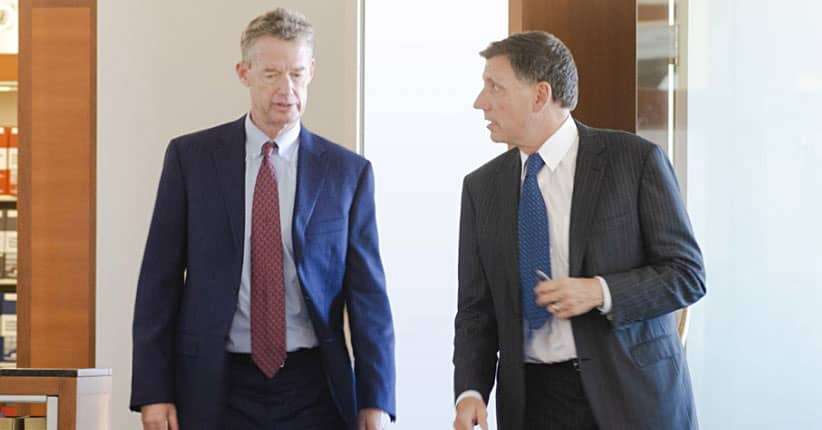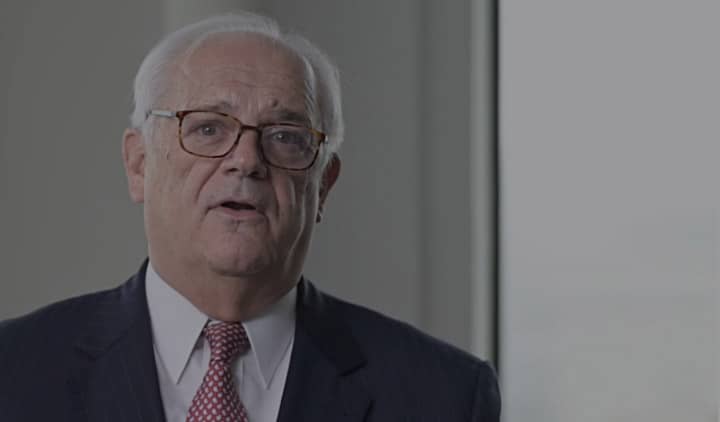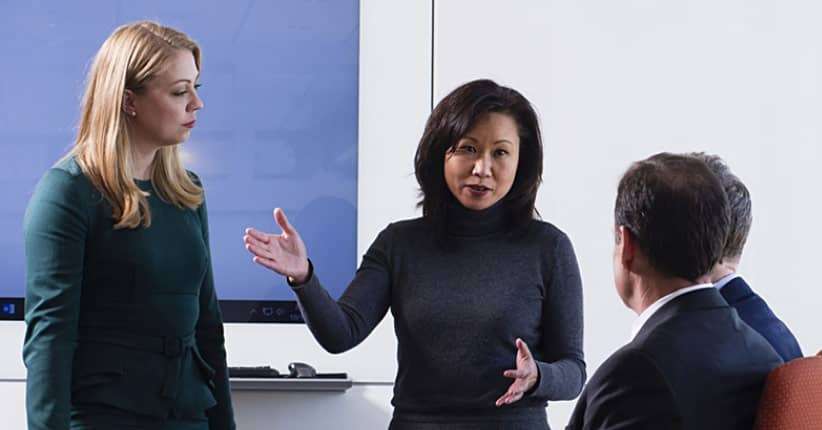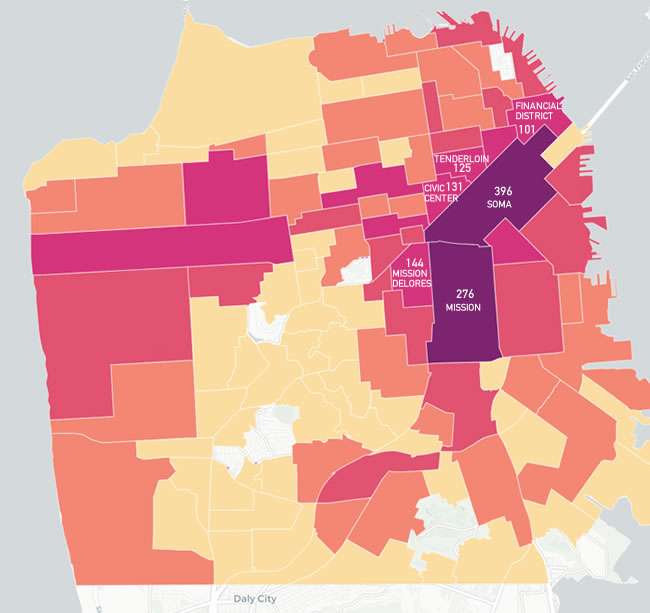
San Francisco is widely considered one of the most bike-friendly cities in the nation, scoring high in both road safety and accessibility to the city’s diverse neighborhoods.
However, despite the city’s embrace of bicycling as a viable method of transportation, its compact intersections and frequently busy roads still make bicycle collisions a regular occurrence, with many leading to serious injury and even death.
We wanted to properly assess where bicycle collisions occur more frequently across the city, so we turned to data visualization firm 1Point21 Interactive for help. We analyzed five years of CHP crash data from 2013-2017 to pinpoint any hot spots of where cyclists are at risk of being struck by motor vehicles.
During the study period, there were over 3,000 motor vehicle collisions involving cyclists in San Francisco, leading to 17 fatalities and more than 2,700 injuries. Through our analysis, we identified the most dangerous areas, specific intersections, and neighborhoods for cyclists in San Francisco – based on crash volume and injury severity.
Interactive Map of San Francisco Bicycle Crashes
*Zoom and hover to reveal more detailed information for each zone. For best mobile experience, rotate device.
The 20 Most Dangerous Places for Cyclists in San Francisco
We conducted a kernel density analysis to identify clusters of high-crash activity within San Francisco – any zones with ten or more bicycle crashes within close proximity of one another.
In total, we found 24 high-crash zones accounting for 848 total bicycle collisions and 763 injuries.
Note: The Zone column is an approximate center area of each zone to allow readers to easily locate zones on our map. The zone may cover a larger or smaller area than described.
| Rank | Zone | Crashes | Severe Injuries | Visible Injuries | Total Injuries |
| 1 | Union Square | 225 | 13 | 91 | 190 |
| 2 | Hayes Valley – Market St | 135 | 6 | 52 | 122 |
| 3 | Tenderloin – Polk St | 82 | 6 | 32 | 76 |
| 4 | Mission District – Valencia St | 60 | 2 | 20 | 53 |
| 5 | Haight-Ashbury – Divisadero St | 46 | 4 | 26 | 45 |
| 6 | Mission District – 14th St | 36 | 5 | 12 | 34 |
| 7 | SoMa – 8th Street | 25 | 2 | 9 | 20 |
| 8 | SoMa – Market Street | 24 | 0 | 12 | 24 |
| 9 | Fisherman’s Wharf – North Point St | 21 | 0 | 9 | 20 |
| 10 | Duboce Triangle – Church St & Market St | 18 | 2 | 6 | 16 |
| 11 | Tenderloin – Golden Gate Ave & Hyde St | 18 | 0 | 8 | 15 |
| 12 | Fillmore District – Webster St | 17 | 2 | 4 | 17 |
| 13 | The Panhandle | 16 | 4 | 5 | 16 |
| 14 | SoMa – I-80 | 16 | 1 | 8 | 15 |
| 15 | Nob Hill – Polk St | 13 | 0 | 9 | 13 |
| 16 | The Castro -17th St & Church St | 12 | 2 | 6 | 12 |
| 17 | SoMa- 13th St & Mission St | 11 | 4 | 3 | 11 |
| 18 | Mission District – Valencia St & 22nd St | 11 | 2 | 4 | 8 |
| 19 | Mission District – Mission St & Cesar Chavez | 11 | 1 | 5 | 10 |
| 20 | SoMa – 5th St & Howard St | 11 | 0 | 3 | 8 |
| 21 | Fisherman’s Wharf – Pier 39 | 10 | 3 | 3 | 10 |
| 22 | Golden Gate Park | 10 | 1 | 5 | 10 |
| 23 | South Beach | 10 | 1 | 4 | 9 |
| 24 | Mission District – Mission St & 17th St | 10 | 1 | 2 | 9 |
Locations of the Most Dangerous Zones
- Union Square: With 225 bicycle collisions leading to 190 injuries and 1 fatality, this zone had the highest amount of collisions and injuries in the study. Located in one of the most pedestrian-heavy areas of San Francisco, this zone encompasses roughly ten blocks of Market Street, along with parts of 6th and 7th
- Hayes Valley: Ranked second, this zone accounted for 135 total crashes, leading to 122 injuries. Located in Hayes Valley, this zone is only three blocks south of the aforementioned Union Square zone.
- Tenderloin: Stretching nine blocks of Polk Street, this zone had a total of 82 bicycle crashes, leading to 76 injuries – the third-most dangerous zone in San Francisco.
Other Notable Zones
- Mission District: This neighborhood was home to five zones in our study, including the fourth-ranked zone – a four-block stretch of Valencia Street that had 60 total crashes and 53 injured.
- Haight-Ashbury: This small zone of collisions on Divisadero Street was the fifth-most dangerous zone in our study, accounting for 46 crashes and 45 injured.
- Fisherman’s Wharf: This popular tourist attraction had two zones in our study, including a hotspot on North Point Street and Leavenworth Street totaling 21 bicycle crashes and 20 bicyclists injured.
- Golden Gate Park: Located at Crossover Drive and Martin Luther King Jr. Drive, this zone accounted for 10 crashes, leading to 10 injured.
San Francisco’s Bicycle Crash Hotspots
In total, we found 50 intersections where five or more bicycle crashes occurred within 150 feet. We then ranked them using our Bicycle Danger Index (BDI), a score that takes crash volume and injury severity into account.
[wpdatatable id=12]Notable Intersections
- Octavia St & Market St: This intersection has the highest BDI, with 20 bicycle crashes leading to 18 injured.
- Valencia St & 14th St: Ranked second, this intersection accounted for 15 total crashes and 14 injured.
- Market St & 5th St: This intersection had a total of 17 collisions at 15 injured for the third-highest BDI in our study.
- Market St & 2nd St: Accounting for 13 bike crashes and 12 injured, this intersection ranked fourth among all intersections in our study.
- Masonic Ave & Fell St: With 11 crashes leading to 12 injuries, this intersection ranked high at fifth due to the large number of severe injuries with 3 – the same amount as the top four intersections combined.
- Market St & 3rd St: Although this intersection tallied a modest 7 crashes, these accounted for 10 injuries, 4 of which were severe – the highest amount of serious injuries on the list.
Within this list, there were three intersections which had fatalities – one each:
- Harrison St & 8th St: 9 crashes, 6 injured
- Howard St & 7th St: 5 crashes, 7 injured
- Folsom St & 6th St: 6 crashes, 5 injured
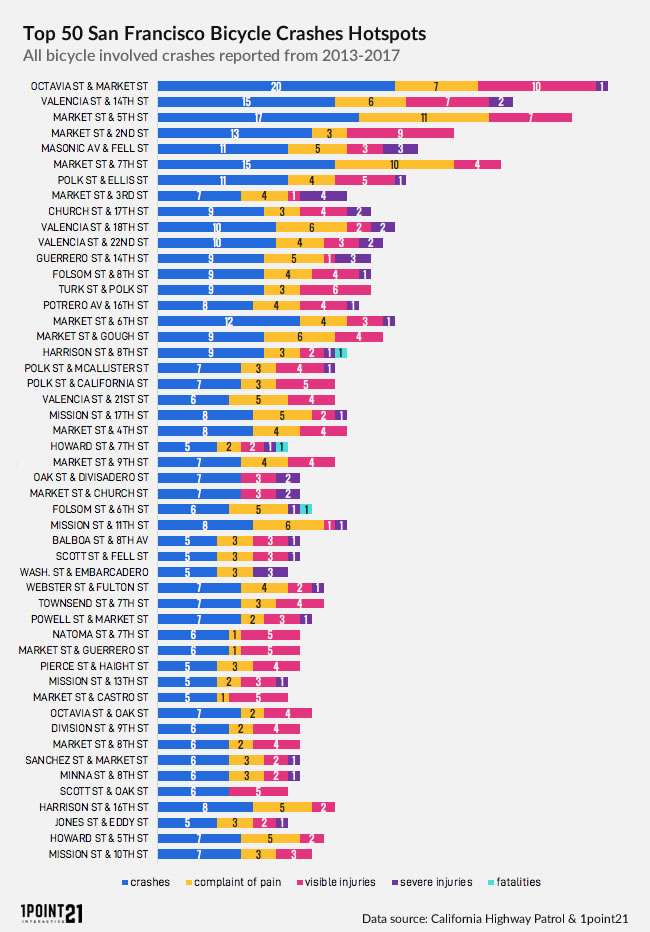
Bicycle Crashes by Neighborhood
When categorized by neighborhood, SoMa and the Mission District had by the highest amount of bicycle crashes, with 396 and 276 crashes respectively. This aligns with our intersection and zone data as well, as most problem areas are located within these two neighborhoods.
Other notable neighborhoods include Mission Dolores (144 crashes), Civic Center (131), the Tenderloin (125), the Financial District (101)and Union Square (96).
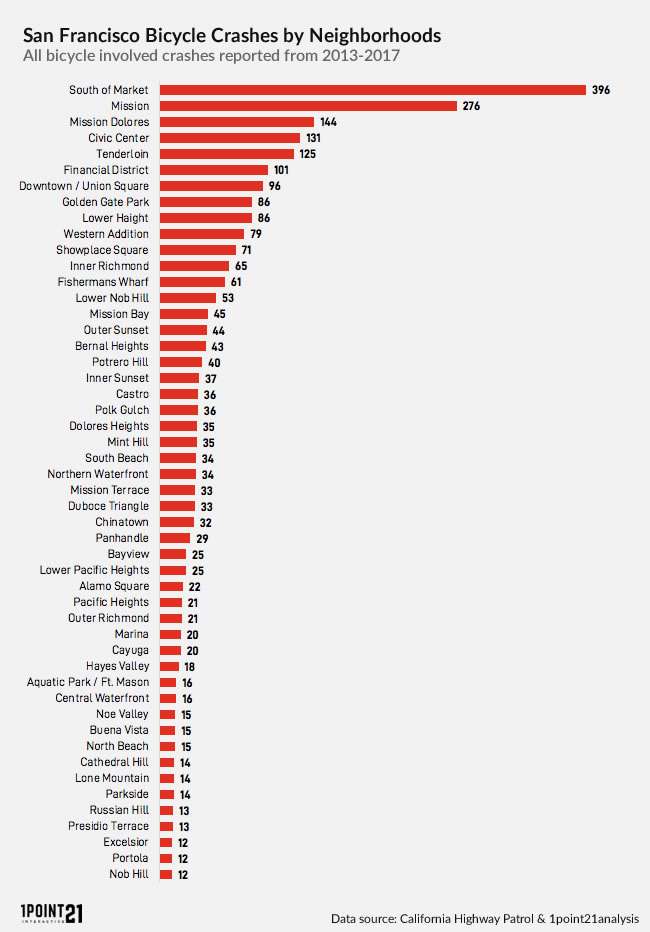
Tip for Safer Bicycling on San Francisco Streets
As the number of bicyclists rises, it is important to practice proper safety procedures on San Francisco’s busy roads.
As a motorist, it is highly recommended to:
- Be alert for bicyclists on the road at all times. Distracted driving is frequently cited as a common reason for bicycle accidents. Keeping undivided attention on San Francisco’s heavily populated city roads can prevent tragedy on your normal commute.
- Share the road whenever necessary. Bicyclists have the same rights as motor vehicles on San Francisco’s roads. Maintain proper road etiquette and treat them as if they were another car on the road. Do not attempt to overtake them if they are making a turn or trying to change lanes – other vehicles may follow suit and speed up, thinking the road is clear.
- Be careful when backing up or opening the door. Even bumping a bicyclist at a low speed while backing up can result in serious injuries. Be sure to look at your side mirror before opening your door after parallel parking. “Dooring,” the act of opening a door in front of a bicyclist, is not only incredibly dangerous to the cyclist but is also against the law in California.
As a cyclist, you must exercise extreme caution on the road.
- Wear a helmet. A helmet is perhaps the most important safety precaution a cyclist can undergo before riding. It not only prevents serious injuries but is also required by law in California.
- Always ride in designated bike lanes, whenever possible. San Francisco has an abundant number of designated bike lanes, including protected lanes. Stick to them whenever necessary to maximize your safety.
- Frequently make eye contact with others on the road. This is one of the most effective ways to get the attention of other riders and drivers, ensuring you are not overlooked on the road.
- Obey all road signs and use hand signals. You are considered another vehicle on the road and must abide by all the rules that other drivers follow as well.
- Improve your visibility in low-light periods. California law requires that all bikes must have rear reflectors and a front white light. A flashing rear light is highly recommended to ensure that other drivers see you on the road at night. Additionally, try to wear brighter clothes to boost visibility if you are biking during periods of low light.
Data and Methodology
Crash data comes from the California Highway Patrol’s Statewide Integrated Traffic Records System for the years 2013 – 2017. When geolocation data was not available, we geocoded records using cross street information. Records without cross street information were eliminated from our analysis.
High crash zones were identified using a Kernel Density Estimation and GIS software.
Dangerous intersections include all crashes that were marked intersection related or occurred within 150 of the cross streets provided. Our rankings were derived by applying our BDI formula to the results. Our BDI takes crash volume and injury severity into account. Fatalities, severe injuries and visible injuries are weighed heaviest in the index.
